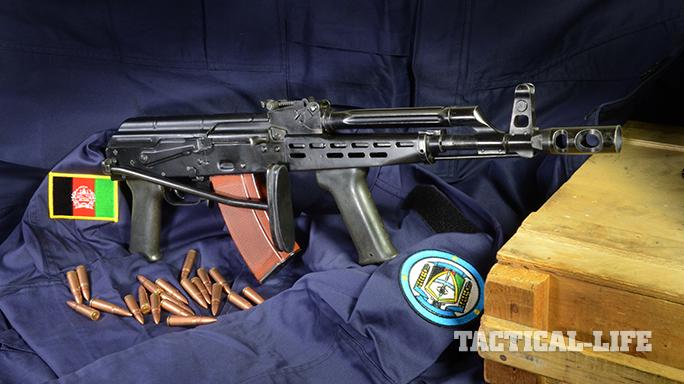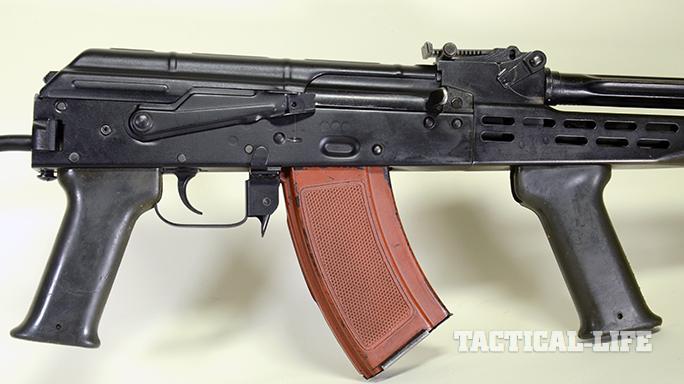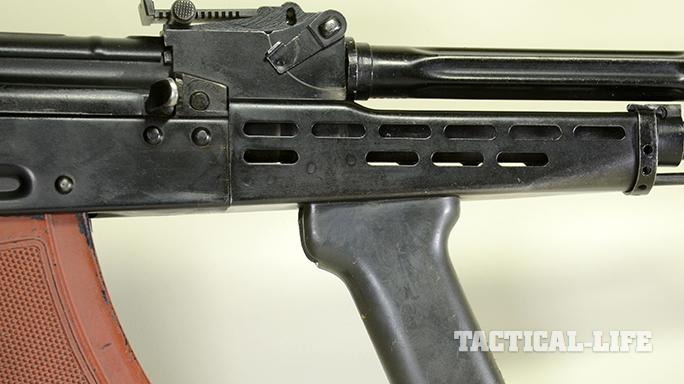I have always thought highly of the Russian AKSU since I first fired one over 20 years ago. However, it is chambered for the 5.45x39mm, and I always felt a compact 7.62x39mm carbine would be even better. As a result, I was happy to learn that some of the former Warsaw Pact countries had developed their own compact weapons in this chambering. The one with which I am most familiar is the AMD (Automata Módosított Deszant) 65. Based on the AKM-63, the AMD-65 is a short-barreled weapon designed for Hungarian airborne and motorized infantry units. In fact, the “D” stands for Deszant, which indicates paratrooper usage. As the designation indicates, the AMD-65 was developed in 1965, though it did not enter mass production until 1967.
AMD-65 Design

Design specs for the AMD-65 indicated that it should be smaller, lighter and easier to carry than the AKM-63. It had to be in the same chambering (7.62x39mm) as the AKM-63 and have the same operating characteristics. It had to be suitable for officers and airborne troops (and later, armored troops) with a muzzle brake/compensator to counter muzzle rise, use a 20-round magazine but also be capable of taking 30-rounders and have a folding stock that, when folded, did not prevent the carbine from being fired.
- RELATED STORY: Russia’s RPK-74 LMG – A Faithful Servant Since 1974
Since I recently completed a book on the Sten gun and a couple of articles on the U.S. M3 submachine gun, both weapons made from stampings and of all-metal construction, I think it is noteworthy that unlike most versions of the AKM, the AMD-65 is mostly made of steel with a bit of polymer. What makes this particularly interesting is that Hungarian versions of the AKM are usually known for their attractive light-colored wooden furniture. Instead of the usual wooden handguard, the AMD-65 uses one made of perforated steel. Both the pistol grip and vertical foregrip of the AMD-65 are of grey polymer. On a short select-fire weapon such as the AMD-65, the vertical foregrip is a boon for control. Unlike the short-barreled Romanian PM md. 90, which uses the standard Romanian foregrip—one that is known for impeding magazine changes with 30-round magazines—the AMD-65’s vertical foregrip is canted forward for easier reloading.
Advertisement — Continue Reading Below
In a move to ease production and parts supply, the rear pistol grip is the same, but it’s reversed to cant rearward. I think that is quite clever.
Although the AMD-65 works fairly well with 30- or even 40-round magazines, it’s still easiest to reload with 20-round magazines, as the vertical foregrip can still interfere when doing a quick change on the fly. The magazine release is the standard AKM paddle, which is easy to operate with the support hand.
The front and rear sights are standard for AKM-type rifles and carbines. The front sight post is protected by rounded wings. The rear sight’s V-shaped notch is adjustable for elevation out to 800 meters. Two special features of the AMD-65 are the side folding “T” stock and the muzzle brake, which has two good-sized openings on each side. To release the stock when folded, you must depress a button under the receiver. This might get easier with practice, but at the range I found that I had to flip the AMD-65 over so I could apply thumb pressure to the release while applying palm pressure to the stock strut when folding or unfolding it. Since the muzzle brake is fitted, the AMD-65 does not have a bayonet lug.
Advertisement — Continue Reading Below
There were some complaints from troops who were issued the AMD-65. Some felt that it wasn’t accurate at longer ranges due to the short barrel and shortened sight radius (4 inches less than with the AKM-63). Based on shooting the AMD-65, I think there is a greater culprit affecting the carbine’s accuracy. The “T” stock is not very comfortable against the shoulder, especially in full-auto fire. But, even worse, it’s impossible to get a good cheekweld when firing using this stock. It is even worse than typical AKM under-folding stocks. However, since it was primarily intended for use by assault troops such as paratroopers and armored infantrymen who would have more need for short-range firepower, this was not considered a major issue. In fact, I understand that armored infantrymen trained to shoot it with the stock folded through firing ports. Using the AMD-65 a lot on full-auto during an assault would create another problem, however. The metal handguard was known to heat up quickly. The short barrel and muzzle brake also were known to make it very noisy.
Present-Day Usage

It is my understanding that the AMD-65 was used by Hungarian troops from 1967 to 2006. However, the AMD-65 is still widely encountered in the world’s trouble spots, as it was sold in places such as Angola, Georgia, Mozambique, Lebanon, Laos, Gaza and the West Bank, Syria, Sudan, Somalia, Yemen and Zimbabwe, among others. It is widely used by the Afghan National Police and has been used by many private contractors in Afghanistan and Iraq.
Many of the AMD-65s supplied to the Afghan Police are likely ex-Hungarian military arms, as the Afghans started receiving them around 2006, when they went out of Hungarian service. I have seen figures to the effect that the Hungarians “donated” 39,000 AMD-65s and the U.S. purchased 45,000 more for the Afghan Police. There have been quite a few complaints from Afghans issued the AMD-65. One is that the shorter barrel/sight radius affects its range and accuracy. Given that the AK design is not inherently accurate, this complaint is not a surprise. Even well-trained users of the AK do not find it to be a tack-driver. I’ve wondered if the complaints might arise because some of the Afghan Police would prefer that they had weapons mounting optics. I have seen photos of weapons with Picatinny rails added to the AMD-65 steel handguard/receiver. For the police mission, the shorter barreled AMD-65 would seem to be a good choice since its operating system is the same as other AKs, a design with which the Afghans would be familiar.
Advertisement — Continue Reading Below
Running Hot

Another complaint is the overheating of handguard, which is valid. On the other hand, the Afghans are not known for fire discipline; instead, they seem to like firing off full magazines on full-auto, often into the air. Don’t forget at least a few “friendly fire” incidents in Afghanistan resulted from “rejoicing” Afghans spraying tracer rounds into the air around U.S. aircraft who assumed they were being fired at. Also, with the front pistol grip, it is fairly easy to avoid touching the handguard when firing on full-auto. From photos and videos I’ve seen taken of Afghan Police training, however, it appears many do not use the vertical foregrip, but instead use the magazine as a foregrip. Not only does this shorten the area between the firing and support hands, but it can also affect reliability by exerting pressure on the magazine.
- RELATED STORY: 13 Must-Have Accessories to Push Your AK’s Performance
This may explain some Afghan Police complaints about the AMD-65’s reliability. Generally, reliability is not a problem with AKM-based designs. The AK design is intended to keep running under very harsh conditions without much in terms of maintanence or cleaning. That has normally been my experience. I also don’t remember reading of reliability problems with the AMD-65 among Hungarian troops. Of course, they weren’t in constant combat against the Taliban. My own experience with the AMD-65 is limited. However, I have not had reliability problems the few times I have fired the weapon.
As the U.S. is arming members of the Afghan National Army with 5.56x45mm NATO weapons, some of their AKs are being issued to the Afghan Police as replacements for the AMD-65s. In fact, I cruised some U.S. military sites and most photos showing the Afghan Police being trained over the last couple of years show them with full-sized AKs. I have friends who have trained the Afghan Police, and I don’t remember any of them offering criticisms of the AMD-65, but most were there a few years ago. I don’t know how valid criticisms of the reliability of the AMD-65 are; it may just result from the typical feeling among some troops that the “other guy” has better weapons.
Advertisement — Continue Reading Below
Quite a few parts kits for the AMD-65 were imported into the U.S., with most built with U.S. receivers, compliance parts and barrel extensions to meet the 16-inch requirement. Some were also registered as short-barrel rifles (SBRs) and retained the 12.5-inch barrel, but these were still required to be built as semi-autos. Although I have not seen one, I understand that some kits were built as pistols, thus retaining the 12.5-inch barrel but eliminating the folding stock.
My own experience with the AMD-65 is not extensive, though I have fired the weapon a few times. I did not find any reliability problems but did see justification in most of the other criticisms. I especially find the stock uncomfortable and, as I mentioned before, hard to attain a good cheekweld with. Yes, the metal handguard does heat up, but I noticed another problem with it (and the polymer pistol grip and foregrip). I was firing the AMD-65 on one cold day—below freezing with some wind chill—and found that the handguard and foregrip remained extremely cold without gloves. I guess the shortened sight radius may have affected my accuracy to some extent, but to be honest, I never have shot AKs that accurately with the exception of one semi-auto Polytech I own that shoots really well. I’ve shot the AMD-65 on plates at 50 and 100 yards and found the accuracy acceptable. And it was very loud due to the brake!
I have to admit a lot of my interest in the AMD-65 stems from the fact it is so widely used in “interesting” places. I don’t work in those places as I used to sometimes, but I still feel the need to be familiar with weapons I might encounter there—call it refusal to admit I’m getting older. That’s as good an excuse as any to shoot the AMD-65 if given the chance. But, really, who needs an excuse?
Advertisement — Continue Reading Below
Caliber: 7.62x39mm
Barrel: 12.5 inches
Weight: 7.1 pounds (empty)
Advertisement — Continue Reading Below
OA Length: 27-34.4 inches
Stock: Wire folding
Sights: Front post, adjustable rear
Advertisement — Continue Reading Below
Action: Piston-operated
Finish: Matte black
Capacity: 30+1
Advertisement — Continue Reading Below
MSRP: N/A



































